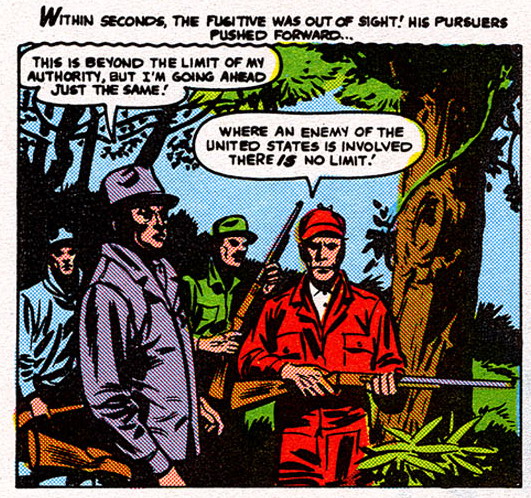 Every now and then someone writes an article decrying the editorial changes that sometimes accompany reprints of classic comic book stories. More often than not it is nudity or other adult themes that get changed or censored. I find it odd that pen drawings of semi-nude figures were okay for young adults to see in the 1970s but is no longer considered appropriate today. I come down on the side of those that want reprints to remain as they were originally intended to be published, even if they contain inappropriate imagery and themes. This is for history's sake and as a cultural measurement. We can not as a people accurately gauge our progress if we sanitize the past.
Every now and then someone writes an article decrying the editorial changes that sometimes accompany reprints of classic comic book stories. More often than not it is nudity or other adult themes that get changed or censored. I find it odd that pen drawings of semi-nude figures were okay for young adults to see in the 1970s but is no longer considered appropriate today. I come down on the side of those that want reprints to remain as they were originally intended to be published, even if they contain inappropriate imagery and themes. This is for history's sake and as a cultural measurement. We can not as a people accurately gauge our progress if we sanitize the past.
It is a fantasy, but if nothing else I'd like to see two versions of classic comic books made available. One version honestly printed for historic value and scholarly pursuit, the other version updated and annotated only where a change would make the book accessible to everyone. There are thousands of old books that could not be reprinted because of old and unenlightened viewpoints. There are many great Golden Age and Disney titles that I could not recommend to readers because of the content, though I understand some of the old Disney strips had the appearance of some characters changed. I know I'd enjoy those Will Eisner Spirit collections more if the racial stereotypes were, to coin a phrase, De-Pie-Faced.
Yet, comic books have had a hard time being accurate mirrors of society. While the general populace will live and think one way, popular media will present it as nothing remotely resembling reality. Comics books are realistically shaped by market forces and often what the creators erroneously believe contemporary culture and society is actually like or what they judge it should be like. Marvel (nee Atlas/Timely/Etc) under the guidance of Stan Lee and others was most popularly notorious for this. Wherever it was among the political and cultural spectrum that contemporary popular society resided, Stan Lee was right there. Whether the subject was Communism, a schizophrenic version of Feminism, environmentalism, Civil Rights and even the advantages of the Military/Industrial complex Stan Lee knew the market, was aware of what it would accept and was astute in type of comic book to produce.
One often has to read between the panels to discern where the social and political bias lies in comic books. Company, editorial and creator agendas, opinions and ploicies are often vastly different from the other. Rarely were they all ever on the same page. For decades comic books were little more than propaganda pamphlets and this was most obvious during the 1940s and 1950s. This was more a survival tactic than anything else. Knowing that the only way to survive against parent groups and government interference was to not offend or rock the boat, most companies adopted a "go along to get along" policy that lasted for the most part well into the 1970s. It was really only the subversive creativity of writers and artists and their stealthy rebelliousness as they chafed under the Comics Code that allowed any story to deviate from a bland, inoffensive all-ages fare.
There are many examples scattered through Marvel, DC and Charlton where the story is heavily biased towards the prevailing status quo. I touched on this previously in the post Iron Man vs. Titanium Man: Then and Then. In the 15 years between the original story and the re-telling Tony Stark went from being unable to beat a helpless foe because he, as a symbol of America was morally and ethically superior to other political systems to someone who would get off on being able to utterly humiliate and crush an enemy. Each story was firmly based in the prevailing sentiment of the era.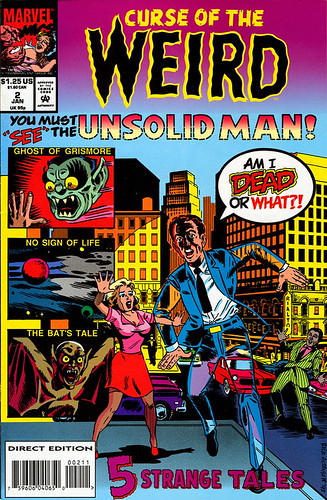
One of those stories that was changed between being originally published and reprinted is the story The Unsolid Man from World of Fantasy #13 (August 1958), reprinted in Curse of the Weird #2 (January 1994). The story is marginally about a fugitive running from the law with a bit of science fiction thrown in. There is some silliness about being out of sync with time though it is really better told as an hallucination caused by stress and physical pressure from a ride on a rocket sled.
Between 1958 and 1994 the story was changed ever-so-slightly in content due to the perception of who could safely be demonized by American culture. In the original story a man is labeled a traitor and hounded by the authorities for exercising free speech. It is never clearly stated what the character, Benson, did to deserve such official enmity but he appears educated, carries a guitar and is traveling through Texas. He could be a folk-singer causing unrest through his songs, working for civil rights or a Marxist. What makes this story subversive is that while a reader could easily assume the character was a communist, the props suggests he was more of an "egg-head" and a crank disliked by the powers that be.
That the story was changed was something of a waste of effort. The original story would have had the benefit of perhaps making a new or young reader think and analyze the content of the tale. But an already mediocre tale was retconned to make the story completely forgettable and yet another entry in Marvel's long history of plots driven by the cliche' of the Red Menace.
Benson was called a Communist later in the story, but this was also something as a catch-all phrase used as a pejorative against anyone who did not act like one of the sheep. This is where the creators may have made their opinion towards the establishment known. There is also a little humor in one panel referring to the limits, or lack thereof, of government powers that may be unintentional but closely parallels issues today. Benson is basically attacked and ostracized by Law Enforcement only for his unpopular views. In 1958 this was widely accepted as a valid tactic for silencing those upsetting the apple cart (and is enjoying something of a resurgence in recent years).
In the 1994 reprinting of the story in the crime of lecturing an alternative viewpoint is changed. It is no longer in vogue to beat up intellectuals, no matter how wrong-headed and weird they may be and the Constitution is used and referred to instead of being outright ignored. Benson is not lecturing in this telling and is now accused of calling for the violent destruction of government facilities.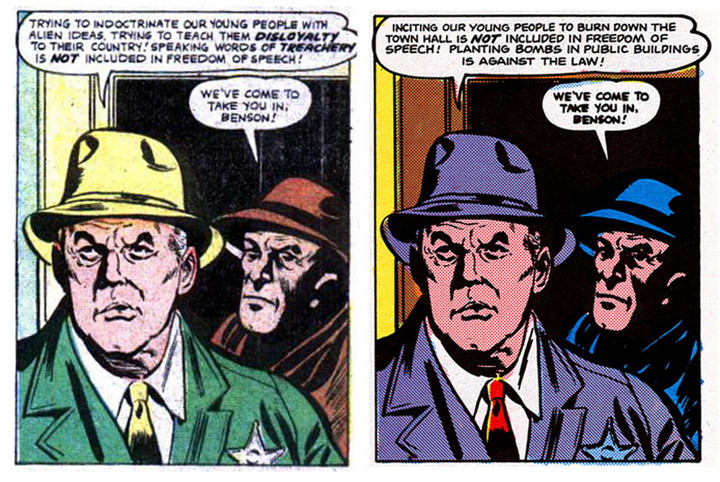 In 1994 the character is no longer a harmless crank. Benson is now depicted as dangerous and unstable. The Law Enforcement officers are not ignorant thugs intolerant of other viewpoints but are actually heroes, rooting out evil as it preys on their children.
In 1994 the character is no longer a harmless crank. Benson is now depicted as dangerous and unstable. The Law Enforcement officers are not ignorant thugs intolerant of other viewpoints but are actually heroes, rooting out evil as it preys on their children.
Here is the original version of The Unsolid Man from World of Fantasy #13 (August 1958).
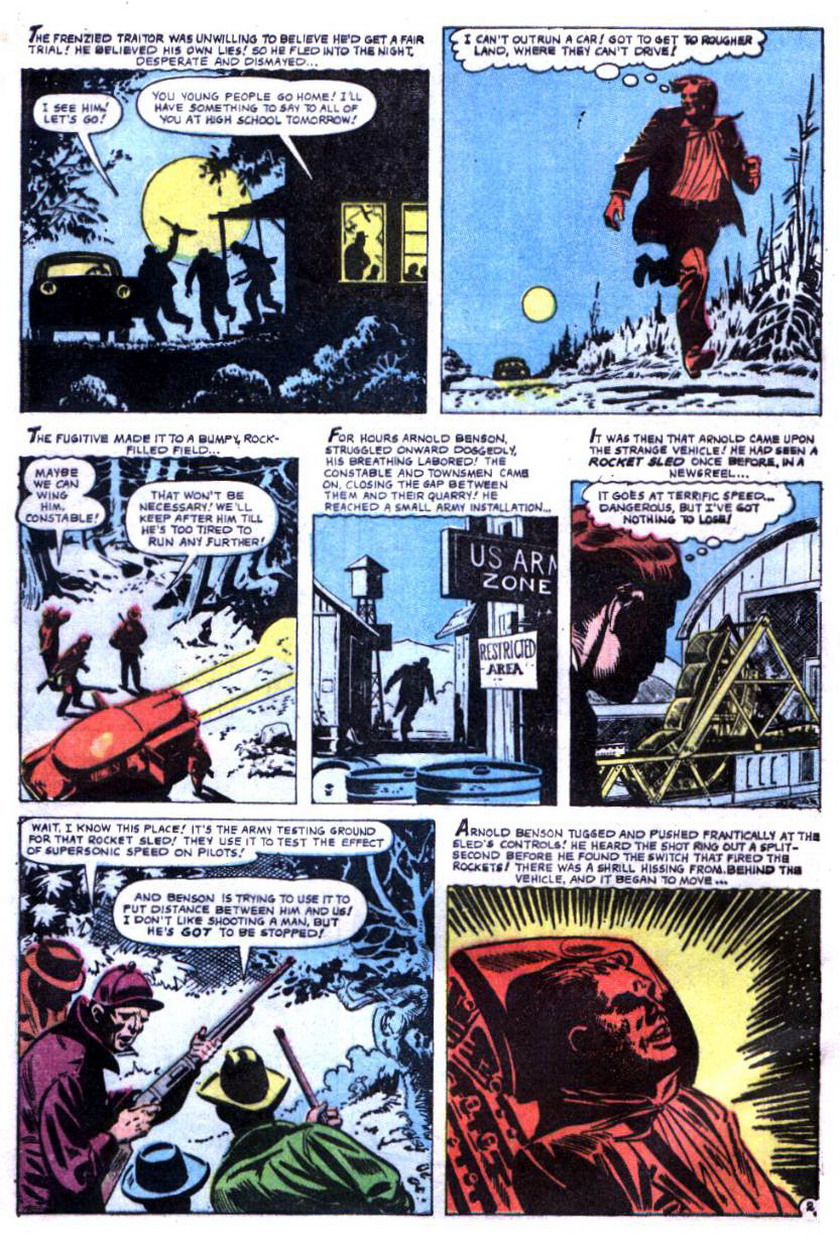
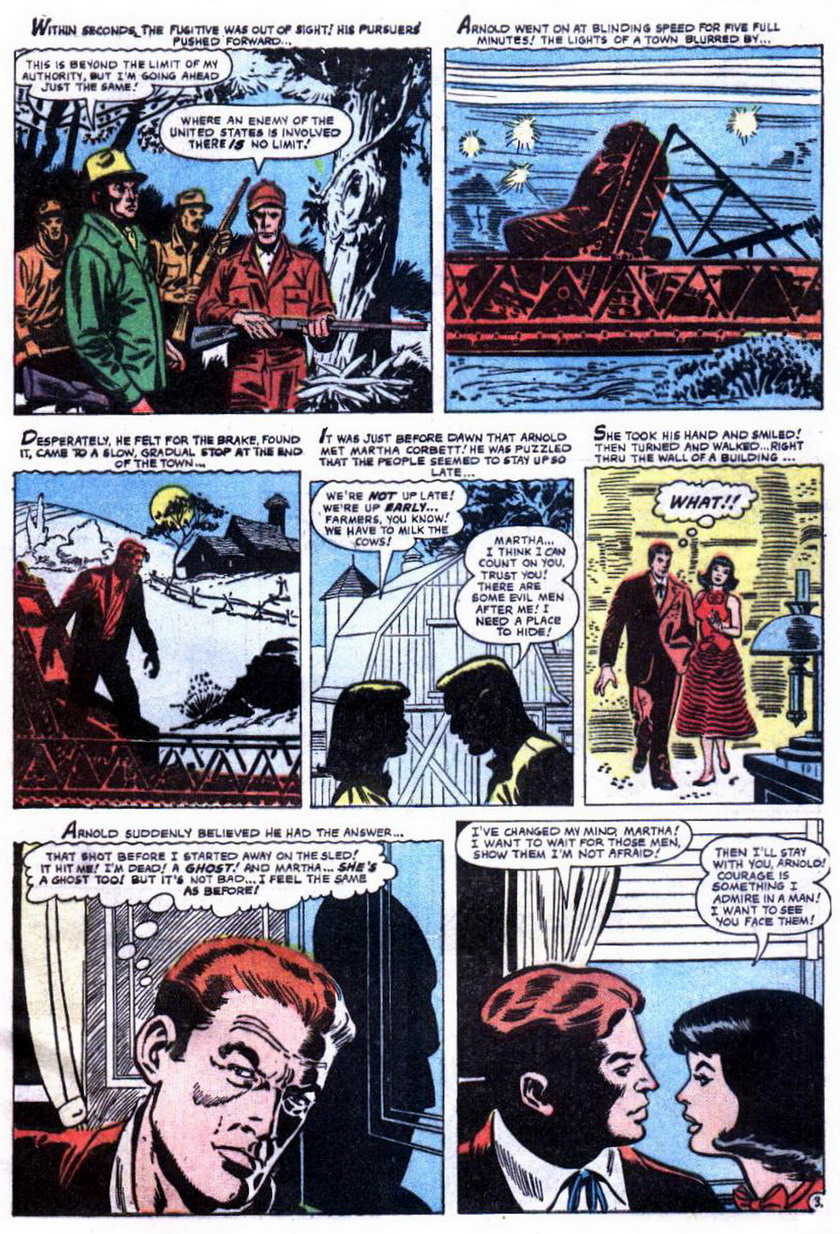

Thursday, September 04, 2008
The Unsolid Men
Posted by
Sleestak
at
9/04/2008 09:00:00 AM
![]()
![]()
Labels: culture, Politics, Seduction of the Innocent
Subscribe to:
Post Comments (Atom)

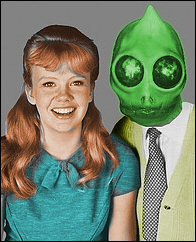

























Why did they change the colors, as well? That guy looks a lot sillier in purple...
ReplyDeleteOne of the many reasons I love this blog is that you find obscure, unusual comics to share. Most average people know comic books as the things that you find Superman and Batman in. They have no access to the vast history of weird that's beyond the ultra-famous characters. So thank you :)